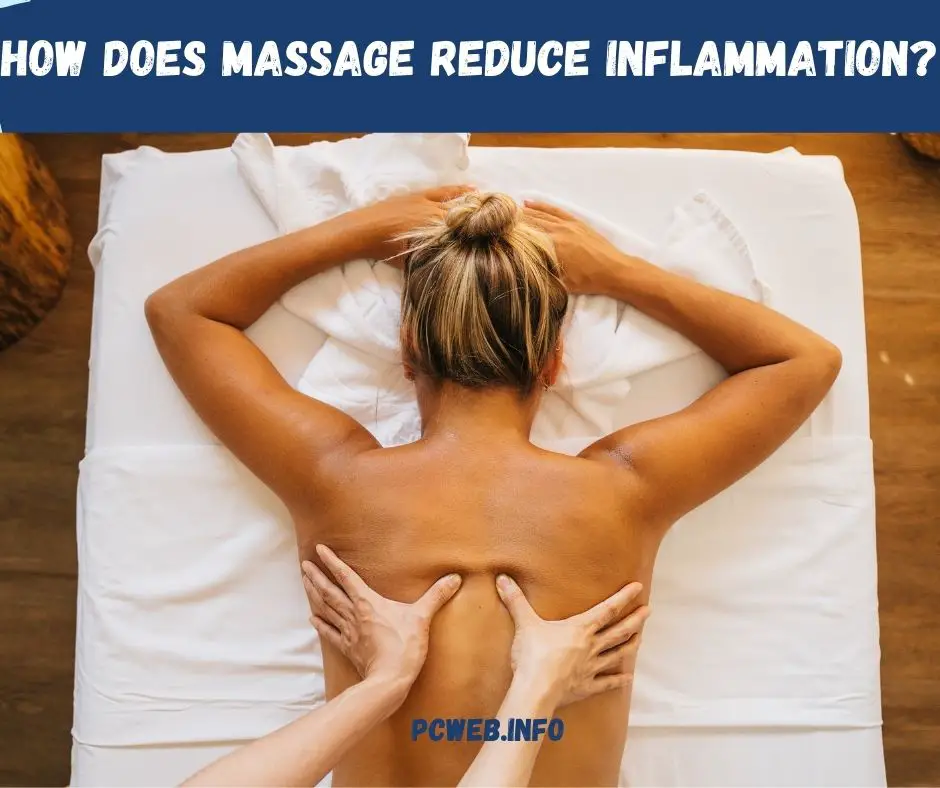How Does Massage Reduce Inflammation? In massage, pressure is applied to the body as well as pushed around with a range of movements, such as hand movements, finger movements, elbow movements, and, in some circumstances, knee movements.

Massage therapy involves manipulating your muscles, tendons, and ligaments to improve your health and well-being. It is most commonly administered by skilled sports massage therapists.
Massage therapy comes in a variety of forms, but the two most common are relaxation and rehabilitation. During a relaxation massage, the focus is mainly on relaxing muscles and soft tissues with different pressures, whereas rehabilitation massage focuses on deep tissues and is commonly found in hospitals, chiropractic offices, and clinics.
Many medical and therapeutic benefits can be derived from massage therapy. Maybe you just want to relax, or maybe you want to reduce chronic pain or inflammation, or even improve your mobility. The benefits of receiving a massage are numerous.
For example, researchers found that massage treatment can reduce blood pressure in hypertensive women in a recent study published in the International Journal of Preventive Medicine. Additionally, the initial effects of lower blood pressure may last for up to 72 hours after the massage.
The rehabilitation massage area includes several subcategories, each of which emphasizes a popular approach. A Swedish massage, developed by Dutch practitioner Johann Georg Mezger, consists of long gliding strokes applied to the muscles in the direction of blood returning to the heart, improving circulation and reducing muscle tension.
Similar to Swedish massage therapy, deep tissue massage uses more intense pressure to relieve chronic muscle tension. This type of exercise targets muscles, tendons, and fascia deep in the body.
Deep tissue massage is similar to Swedish massage therapy, but it uses deeper pressure to relieve chronic muscle tension in the deep layers of muscle tissue, tendons, and fascia.
During vigorous exercise, muscles or joints can be injured, resulting in acute or chronic inflammation, such as tennis elbow. Injury can be caused by simple mistakes like not stretching, warming up, cooling down before/after exercise, or using the wrong technique.
Despite these precautions, you can still cause micro-injuries, which can happen to people who do not exercise. This can be caused, for example, by putting your foot down the wrong way on the stairs.
Acute inflammation occurs as a result of an increase in blood flow, blood proteins, and white blood cells in the area of injury. This can occur immediately after an injury that has caused acute inflammation.
Causes of Inflammation
A number of factors may contribute to inflammation, including stress, dietary choices, artificial chemicals in food, water, medicines, and cosmetics, and pathogens such as bacteria and viruses.
Scientists acknowledge many of the causes of inflammation, but they are less forthcoming about possible ways of treating it. Although anti-inflammatory drugs have proven effective, long-term use can result in dangerous side effects, such as osteoporosis, heart disease, and hemorrhaging.
How does massage help?
Depending on the severity of the inflammation, massage therapy has been shown to reduce pain and swelling and increase muscle repair. Studies have shown that massage increases blood flow, reduces stiffness, and relieves discomfort.
Massages can reduce inflammation and increase fluid retention and circulation. Petrissage and lymphatic massage are both massage techniques that help remove fluids from tissues, which is beneficial for chronic inflammatory conditions. Studies on flow-mediated dilation (FMD) show that massages to the lower extremities are significantly more effective at reducing inflammation than massages to the upper extremities.
It is recommended that you consult your physician prior to using massage therapy to support inflammation, in case it is contraindicated for your particular injury type. Be sure to also disclose the extent of your pain to the massage therapist. It is always advisable not to perform any massage if there is too much pain and inflammation.
Massage and Chronic Inflammation
With chronic inflammation, a massage therapist needs to pay attention to how the pain levels in the client’s body may vary. White blood cells are generally circulated through full body massage, which increases their efficiency and worsens the client’s condition.
With our significant increase in full-body circulation, we offer a variety of treatments to alleviate body systems:
- Improved organ efficiency can be achieved by abdominal massage. In Chinese medicine, Chi Nei Tsang is a form of abdominal massage that can be beneficial in this regard.
- The client receives myofascial benefits from stretching without significantly impacting their circulation.
- Blockages in the body’s myofascial network can be released through myofascial release. When the client experiences flare-ups, this type of release is well tolerated.
- The practice of Shaitsu and Thai massage combines stretching with a focus on musculotendon pathways and specific muscle regions. Based on the client’s tolerance level on any given day, they can vary in intensity.
The Bottom Line: How Does Massage Reduce Inflammation?
Massage therapy can reduce inflammation, no doubt about it. There have been a few decent studies on the subject.
Massage therapy is not proven to counteract muscle inflammation caused by exercise, as there is no systematic research to support that claim. Apart from massage therapy that can reduce inflammation, massage therapy could also prevent injuries from occurring, particularly micro-injuries.
Attending massage therapy as part of regular physical activity may have benefits for those that are physically active including increased flexibility and other non-medical advantages that reduces the risk of injury and promotes faster recovery.
If massage therapy is administered to you properly by a professional massage therapist, it can reduce inflammation; however, you might find that simply exercising reduces inflammation more effectively than massage therapy.
Read also: Will Massage Reduce Swelling?; Is Massage a Good Business; Tui na massage: definition, description essential; Tui na massage for dogs.
External resource: hfe.co.uk
This post is also available in:
![]() English
English ![]() Deutsch (German)
Deutsch (German) ![]() Español (Spanish)
Español (Spanish)